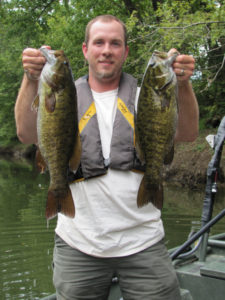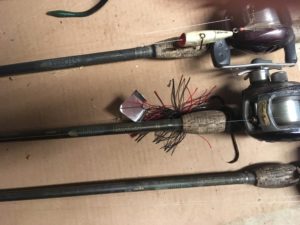Two Tailwater Floats for Summer Smallmouth Bass Fishing
from The Fishing Wire

Float for summer smallmouth
FRANKFORT, Ky. Anyone who loves floating streams for smallmouth bass out of a kayak, canoe or personal pontoon boat did not enjoy last year much at all. Many areas of Kentucky set annual rainfall records in 2018.
It seemed a 3-inch rain hit every third day from spring through fall. Streams flowed raucous and so muddy it seemed you could cut the water with a knife. These conditions are the absolute pits for fishing; you are better served catching up on yardwork.
After a rough start to this year, it seems weather conditions and rainfall levels are returning to normal patterns as we come into the warmer months, the best time of year to stream fish for smallmouth bass from a paddlecraft.
The pop-up thunderstorms common in summer may spike the flow on an average stream or free flowing river, but a tailwater such as the Green River below Green River Lake or the Barren River below Barren River Lake offer more predictable flows in summer.
“You have controlled flow in a tailwater with more stable water conditions,” said Mike Hardin, assistant director of Fisheries for the Kentucky Department of Fish and Wildlife Resources. “The long range forecast calls for a return to normal summer weather patterns.”
The Green River from Green River Lake Dam downstream to Greensburg holds many fat smallmouth bass and offers excellent access. The Barren River from Barren River Lake Dam downstream to Martinsville Ford is another productive stretch for smallmouth bass.
“Green River is still doing phenomenal for smallmouth bass,” said Jay Herrala, stream fisheries biologist for Kentucky Fish and Wildlife. “Green River and Barren River have good size structure in the smallmouth bass population and both rivers offer a chance to catch a 20-inch or longer smallmouth bass.”
Planning a float on either of these streams is simple. Log on to the Kentucky Fish and Wildlife website at www.fw.ky.gov and visit the Stream Fisheries page by typing “stream fisheries” into the search bar on the top right of the page.
On the Stream Fisheries page, the entry for “Lower Barren River” and “Green River, Pool 6” contain a great deal of information about the good smallmouth bass sections of these rivers, none more important than the link to the “Three Day Lake Release Forecast” from the Louisville District of the U.S. Army Corps of Engineers.
Water releases from their respective dams control the fishing on these rivers. The best release levels for fishing on the Green and Barren are under 300 cubic feet per second (cfs) with 100 to 200 cfs ideal.
The first float on the Barren River begins at the Barren River Tailwater Recreation Area and ends roughly 13 miles downstream at the Barren River VPA No. 3 access. Paddlers planning to fish this stretch should launch their boats at daybreak and plan to take out at dusk.
This stretch holds many flowing shoals rimmed with water willow, islands and stream drops. Since this is such a long float, choose lures you can work quickly such as a floating/diving Rapala style stick bait in chrome and black, small medium-diving crawfish-colored crankbaits and 1/8-ounce white spinnerbaits.
Work these lures along the willow edges of the flowing shoals and in the moving water above and below stream drops.
The next float begins at the Barren VPA No. 3 access and ends about four miles downstream at the Claypool Ramp on the south side of the Barren at Martinsville Ford.
This section of the Barren makes many subtle turns. Anglers should probe the rocky, flowing outside bends with 4-inch skirted double-tailed grubs in green pumpkin rigged on a 3/16-ounce Shakey head.
The Barren constricts between islands and gravel bars several places in this stretch, increasing the river’s flow. Tube jigs in green pumpkin rigged on 1/8-ounce heads draw strikes when slowly worked in the seam where fast current meets slower in these areas.
The Green River offers two manageable floats for smallmouth bass anglers: one about 6 1/2-miles that begins at Roachville Ford and ends at Russell Ford and another of about four miles that starts at Russell Ford and ends at the Greensburg Ramp.
Anglers should use the south side of Roachville Ford access via Thunder Road off KY 417 from Greensburg. The shuttle is much shorter than using the north side of Roachville Ford for access.
The flowing deep runs in this float hold fat smallmouth bass. A 4-inch Senko-style soft plastic stick bait in the green pumpkin magic color rigged on a 1/8-ounce leadhead is tough to beat on the Green in summer. Let the lure tumble in the current and watch the line intently. Green River smallmouths often strike subtly during the warm months.
Fly rod anglers can find great sport throwing bass-sized yellow and black cork poppers in the eddies behind boulders. This presentation also attracts hefty largemouth bass.
About halfway through this float, paddlers will notice a bluff rising in the distance when Meadow Creek meets the Green on the right. The mouth of Meadow Creek to the take-out at Russell Ford is the best smallmouth bass water on this float.
The next float is popular in summer with paddlers, but does not hurt the fishing. This section of the Green is more intimate and downsizing your lures to the Finesse TRD-style soft plastic stick baits often used for the Ned Rig presentation work fantastic in this stretch when rigged weedless on 1/8-ounce bullet-style leadheads. The best colors are green pumpkin goby and blue craw.
A rocky, deep flowing pool about half way between Russell Ford and the KY 417 bridge makes a fantastic place to fish, paddle back to the head of the pool and fish again. The flowing stretch just upstream of the U.S. 68/KY 61 bridge in Greensburg is another productive area for smallmouth bass on this float.
The take-out is on the right just after the U.S. 68/KY 61 bridge in Greensburg.
Paddlers may camp at Green River Lake State Park or stay at the lodge, cottage or camp at Barren River Lake State Resort Park. The Green River Paddle Trail offers cabins for rent at the Greensburg boat ramp in downtown Greensburg.
Enjoy floating two of the best smallmouth bass rivers in Kentucky this summer with more predictable flows than many in our state.
Author Lee McClellan is a nationally award-winning associate editor for Kentucky Afield magazine, the official publication of the Kentucky Department of Fish and Wildlife Resources. He is a life-long hunter and angler, with a passion for smallmouth bass fishing.
(Editors: Please email Lee.McClellan@ky.gov for photos.)
###
Kentucky Fish and Wildlife news releases are available online at fw.ky.gov

